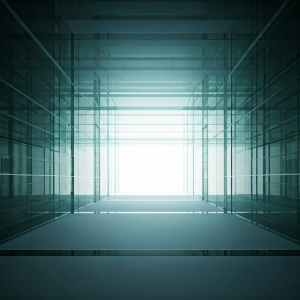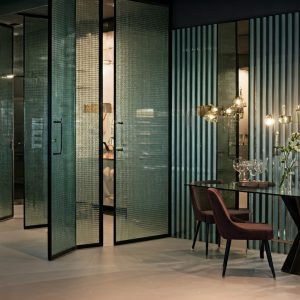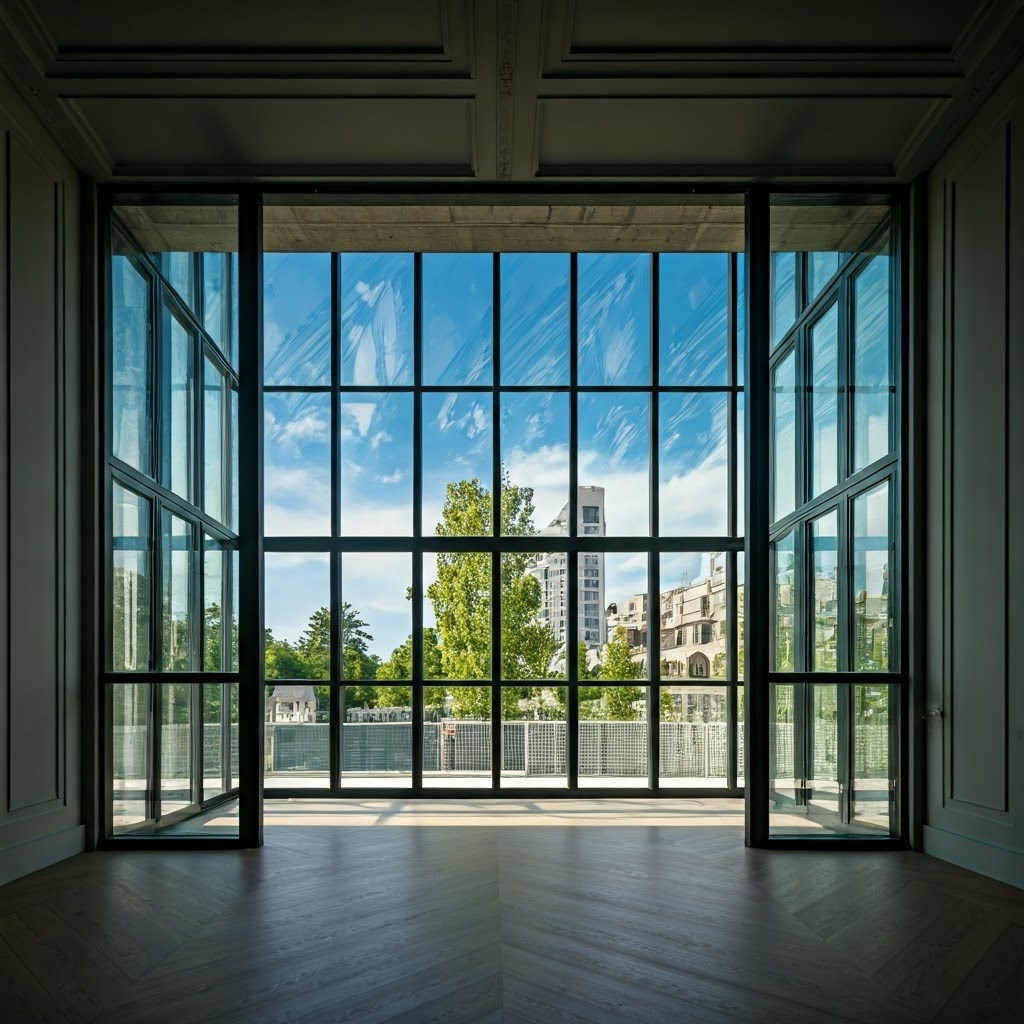Introduction
In interior design, a modern look often comes from using glass works wisely. Interior Glass Designs is appealing because it lets in natural light, makes spaces feel bigger, and adds elegance to any place. Interior designers can use sleek glass partitions and stylish glass furniture. The versatility of glass helps them change living areas and improve their aesthetic appeal.
The Role of Interior Glass in Enhancing Modern Architecture

The use of Interior glass design is not a short-lived trend. It shows a big change in how we see and feel spaces. More architects and interior designers are using glass in modern buildings. They recognize its power to change interior Glass and connect indoor Landscape with outdoor spaces.
Glass is not only visually pleasing. It also has practical benefits. It helps create open and bright areas while still providing separation and privacy when needed. The transparency of glass is great for bringing in natural light. This reduces the need for artificial lighting and helps with energy efficiency.
Boosting Natural Light and Energy Efficiency
One big benefit of using interior glass is that it brings in a lot of natural light. Glass walls, windows, and partitions help sunlight reach deeper inside a building. This brightens up the space and makes it feel more inviting and lively.
More natural light also helps save energy. By cutting down the need for electric lighting during the day, interior glass can lead to big energy savings. This is important today since good design practices focus on being sustainable.
Additionally, glass can also help with passive solar heating. During colder months, it allows sunlight to warm up interiors. This reduces the need for heating systems, which cuts down energy use and lowers the impact on the environment.
Merging Aesthetics with Functionality
The beauty of interior glass is that it combines looks and function. Glass products add openness and lightness to any space. For example, a glass partition can separate a living area from a dining room. Glass shelves can display special items. It brings elegance without taking away from the décor.
From a practical side, glass walls and partitions help define spaces while keeping a feeling of togetherness. This is especially helpful in modern homes and offices that have open layouts. Glass doors and windows let you see into other areas and allow natural light to come in. This makes the inside brighter and more welcoming.
For homeowners and businesses that want to be eco-friendly, using recycled glass products is a smart choice. Choosing recycled glass helps cut down on waste and reduces the impact on the environment from making new glass.
The Versatility of Glass in Interior Design

Glass is a material that works great with many design styles. It fits well in minimalist, modern, classic, and traditional settings. Its neutral nature helps it go with different colors and textures without standing out too much.
This flexibility makes glass popular with interior glass designers who want versatile options. You can use it to highlight a specific area in a room, create space divisions, or bring a hint of simple elegance.
Maximizing Natural Light with Glass Walls
Glass walls are now a key part of modern interior glass design. They change how we feel about light and space. Instead of using solid walls, glass walls let natural light shine deeper into rooms. This makes spaces feel more open and airy.
In homes, people often use glass walls to divide living areas from dining rooms or kitchens. This helps create an easy flow between spaces but still keeps some privacy. They are also great for home offices or studies, as they give a bright and calm place to work.
In business settings like offices and stores, glass walls are popular. They help create bright and welcoming places. You can use them to build private offices or conference rooms while still letting natural light come in.
Creating Illusion of Space with Mirrors
Mirrors are a great tool for interior glass designers. They help to make spaces look bigger and brighter. When you place mirrors just right, you can give the feeling of a larger room. The reflective surfaces help spread light around. This amplifies natural light and brightens dark areas.
In smaller rooms or apartments, putting a big mirror on one wall can make the space feel twice as big. This is a smart trick for narrow hallways or dining areas. Mirrors can also enhance the beauty of things already in the room, like art, chandeliers, or special designs.
If you want to make a bold statement, covering a wall with mirror tiles adds glamour and style. This works great in living rooms, bedrooms, or even bathrooms.
Incorporating Glass Elements in Furniture Design
Glass furniture is becoming very popular again in modern interior design. It brings a classy and stylish look to homes and offices. You can find many options like coffee tables, dining tables, bookshelves, and display cabinets that fit a modern style.
A great thing about glass furniture is its ability to mix well with different decor styles. The transparency of Interior glass helps it match with other furniture, so it does not make the room feel crowded. It makes a space feel light and open.
When you pick Interior glass furniture, think about the design style of your space. If you want a simple or modern look, choose items with clean lines and few decorations. If your room is more traditional, select glass pieces that have detailed designs or metal touches.
Using Frosted Glass for Privacy and Style
Frosted glass is a smart way to add privacy without losing natural light. Its see-through style lets light come in but hides what is behind it. This makes frosted glass a great choice for bathroom windows, shower enclosures, and partitions.
Besides being useful, frosted glass looks classy and fancy in any space. You can use it to create privacy without blocking light entirely. This way, light can still flow through while keeping some separation.
You can find frosted glass in many patterns and designs. This lets you change your space and get the right level of privacy. Whether you want a simple pattern or a striking design, frosted glass will boost the aesthetic appeal of your room while still offering practical benefits.
The Beauty of Stained Glass in Interior Decor
Stained glass has a rich history and stunning beauty. It still attracts homeowners and designers today. It is usually linked with churches and cathedrals, but now stained glass is used in modern home design. It brings art and elegance to houses and apartments.
The charm of stained glass comes from its ability to change regular spaces into amazing visual scenes. The mix of colored glass and light creates a beautiful look. It makes colorful patterns and shadows that move around the room.
You can use stained glass in many ways in home décor. It can work well in windows, doors, cabinet inserts, and lighting fixtures. Whether it stands out as a main piece or serves as a subtle detail, stained glass adds a special and interesting touch to any area.
Enhancing the Aesthetics of Rooms with Glass Art
Glass art has become a popular choice for adding elegance and sophistication to homes or offices. It includes things like blown glass sculptures and fused glass wall hangings. There are many options to improve the look of a room.
The charm of glass art comes from its versatility. It can be abstract or realistic, colorful or in one color, and can be fine or bold. This lets homeowners and interior glass designers find items that fit their taste.
When adding glass art to a room, think about the design theme, color choices, and how much natural light is there. Pick pieces that go well with what you already have and boost the overall aesthetic appeal of the space.
Sustainable Design with Recycled Glass Features
In architecture and interior glass design, more people are focusing on sustainable practices. This shift has led to a demand for eco-friendly materials. Recycled glass is a popular option for homeowners and designers who want to lessen their impact on the environment.
Recycled glass can be used in many design elements such as countertops, tiles, decorative accents, and light fixtures. Its durability, versatility, and aesthetic appeal make it a good choice instead of traditional materials.
When architects and designers use recycled glass, they help cut down on landfill waste. They also support a circular economy. Using recycled materials means we rely less on new resources, use less energy to make products, and help lower greenhouse gas emissions.
Diverse Applications of Interior Glass in Contemporary Designs
The use of interior glass in modern designs goes beyond just windows and doors. Architects and designers are always finding new and exciting ways to use glass. They want to create spaces that are both beautiful and practical.
We can see this with amazing glass staircases and balustrades that bring elegance to a place. Breathtaking glass floors can make a room feel open and connected. The ways to use interior glass are almost endless.
Transforming Spaces with Glass Walls and Partitions
Glass walls and partitions are very popular in modern design. They are a nice way to separate spaces while keeping an open and light feeling. You can see them in home offices, big bathrooms, and stylish workplaces, as they fit in many different places.
The transparency of glass partitions lets natural light come in easily. This brightens up rooms and cuts down the need for more lights. It makes spaces look nice and helps save energy.
Also, glass walls help you see each other while giving some sound privacy. This is really useful in open-plan offices. Here, working together is important, but having quiet spaces for focused work is also needed.
Innovations in Glass Doors, Stairs, and Floors
Innovations in glass making have opened up new and bold uses in building design and home decoration. Glass doors, which once stood for modern style, have now added smart features. This lets people have better control over privacy and how much light comes in.
Glass stairs serve as a strong design feature in modern homes and businesses. They now come with improved safety and new designs that change how we think about architecture. These stairs can be spiraled to seem like they float or follow a simple look with treads that hang in the air, adding drama and elegance.
Glass floors are not as common but bring a stunning design touch. They are often used where there are great views. Glass floors let natural light shine through different levels. This creates a feeling of spaciousness and beauty.
Selecting the Right Type of Glass for Your Architectural Needs
Choosing the right type of glass for your building is very important. There are many glass types, and each has its own special features and benefits. You should think about things like how much light you want, how much privacy you need, how well it saves energy, and safety concerns when making your choice.
It’s a good idea to talk to glass experts and skilled architects. They can help you find the best glass type for the intended use and meet your project needs.
Comparing Clear, Frosted, and Tinted Glass
Clear glass, as its name implies, lets in a lot of light. This makes it perfect for places where natural light is important. People often use clear glass for windows, doors, and partitions. It boosts brightness and makes the space feel open. However, clear glass does not provide much privacy. You should think about this based on how you plan to use the space.
Frosted glass strikes a good balance between allowing light in and providing some privacy. Its see-through quality lets light pour in but hides the view. This makes it great for bathroom windows, shower enclosures, or partitions where privacy matters. There are different ways to make frosted glass, and each method gives a different look and level of opacity.
Tinted glass helps control heat from the sun and reduces glare, while also adding some color. It cuts down on heat that enters, which is good for places with a lot of sun. Tinted glass comes in many shades. This lets architects and designers play with style while keeping light and heat in check.
The Advantages of Tempered and Laminated Glass
Tempered glass, also called safety glass, goes through a special heating process. This process makes it much stronger than regular glass. When it breaks, tempered glass breaks into small, safer pieces. This helps lower the chance of serious injuries. Because of its safety features, people often use tempered glass in busy areas or places where impact matters, like doors, windows, skylights, and shower enclosures.
Laminated glass has two or more layers of glass. These layers stick together because of an interlayer made of polyvinyl butyral (PVB). The PVB holds the glass layers in place if they break, stopping the glass from shattering. Instead, it creates a “spiderweb” effect. This makes laminated glass good for security and it gives excellent sound insulation, too.
Both types of glass have unique benefits. The choice between tempered and laminated glass often depends on what you need. If you want both strength and security, using a mix of tempered and laminated glass could give you the best protection.
Conclusion
In conclusion, using interior glass in building design opens many new options for improving modern spaces. It helps to let in natural light and can include eco-friendly features. Glass is very versatile. You can use mirrors to make a space look bigger or use frosted glass for privacy. Each type adds a bit of style to the interiors. Stained glass looks beautiful, and glass walls show how good things can look and work well. To learn more about the many uses of interior glass and find the best kinds for your building needs, contact Wall Four. Improve your designs with the classic beauty of interior glass.
Frequently Asked Questions
What Are the Benefits of Using Interior Glass in Architectural Design?
Interior glass in building design has many benefits. It lets in more natural light, makes spaces feel larger, and adds beauty. Its transparency and versatility give you a lot of design options for both modern and traditional interiors.
How Can Interior Glass Improve Energy Efficiency in Buildings?
Interior glass is great for facades, windows, and skylights. It lets in more natural light, which means we need less artificial lighting. Also, today’s insulated glass options are very good at keeping heat in or out. This helps reduce energy use for heating and cooling.
What Types of Interior Glass are Best for Privacy and Acoustic Insulation?
Frosted glass and laminated glass are great options for privacy and reducing noise. Frosted glass blocks what you can see but still lets light come through. Laminated glass has a special layer that helps lower sound, making it perfect for quieter spaces.
How to Choose the Right Glass Type for Different Architectural Applications?
Choosing the right glass is important. It depends on things like how clear you want it to be, how strong it needs to be, and how you plan to use it. It’s a good idea to talk with glass experts or architects. They can help you find the best type of glass for your needs.
What Are the Latest Trends in Interior Glass Design for Modern Architecture?
Latest trends feature big glass installations, curved glass partitions, and smart glass that changes transparency. There are also sustainable designs, like recycled glass countertops and decorative elements. These options give exciting design options for modern buildings.


